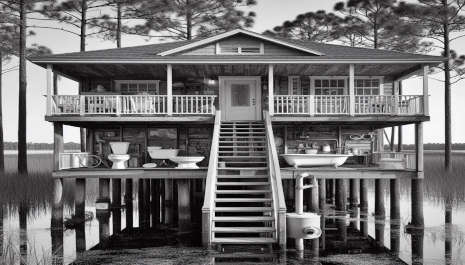How to Fail Your Municipality's Residential Plumbing Final Inspection.

By Murray Wennerlund published 9-18-2024 updated 9-18-2024
1. All Fixtures Set &; Sealed [IRC 22503.5.1]
All plumbing fixtures (sinks, toilets, tubs, etc.) must be securely set in place and properly sealed to prevent water leakage or damage to surrounding areas.
Common Reasons for Failure:
- Fixtures not securely installed or leveled.
- Improper or missing sealant around the fixture.
- Caulking that has gaps, is not waterproof, or is missing altogether.
2. No Leakage on Water or Drain Lines [IRC 2507.7]
Water and drain lines must not have any leakage to ensure proper operation and avoid water damage or mold growth.
Common Reasons for Failure:
- Loose connections at joints or fittings.
- Cracked or damaged pipes.
- Improper installation of drain traps leading to slow leaks or back-flow.
- Inadequate testing before inspection (e.g., pressure or water test).
3. Access Panel Where Applicable [IRC 2903.9.3]
An access panel must be installed where required for valves, shut offs, or other plumbing components to allow maintenance and inspection.
Common Reasons for Failure:
- No access panel provided where needed, such as for water shut-off valves or clean-outs.
- Inaccessible or poorly located access panels.
- Panels that are too small or difficult to open.
4. Septic/Sewer Complete &; Operable [IRC 3001]
The septic or sewer system must be fully installed and operational, with no blockages or incomplete connections.
Common Reasons for Failure:
- Incomplete septic or sewer connections.
- Clogged or improperly sloped sewer lines leading to poor drainage.
- Inspection of the septic tank or drain field not completed.
- Missing required inspections or certifications.
5. Water Heater Location [IRC 2005.2]
The water heater must be installed in an approved location that meets safety and access requirements.
Common Reasons for Failure:
- Installation in an unapproved location (e.g., in a bedroom or bathroom closet without proper ventilation).
- Insufficient clearance around the water heater.
- Inadequate ventilation or air supply for the heater.
6. Water Heater Shut-off Valve [IRC 2903.9.2]
A shut-off valve must be installed on the cold water supply line to the water heater for safety and maintenance purposes.
Common Reasons for Failure:
- Missing or inaccessible shut-off valve.
- Shut-off valve installed in the wrong location (e.g., on the hot water side).
- Valve does not meet code standards (wrong type or material).
7. Water Heater Protection from Physical Damage [IRC 1307.3.1]
The water heater must be protected from potential physical damage, such as from nearby vehicles or other hazards in garages or utility rooms.
Common Reasons for Failure:
- Water heater not properly shielded or protected from vehicle impact in a garage (e.g., missing bollards or barriers).
- Installed in a high-traffic area with no physical protection.
- Improper installation height or exposure to damage-prone conditions.
8. Water Heater Safety Pan &; Relief Valve Waste [IRC 2801.6, IRC 2804]
A safety pan and proper discharge pipe must be installed to prevent water damage in case of leaks or over-pressure from the water heater.
Common Reasons for Failure:
- Missing or improperly installed safety pan beneath the water heater.
- Incorrect or absent relief valve discharge pipe.
- Discharge pipe not terminating in an approved location (e.g., not directed outside or to an appropriate drain).
- Inadequate or missing slope on discharge pipe for drainage.
Failing to meet any of these requirements can lead to a failed final plumbing inspection, often requiring corrections and re-inspection before approval.

